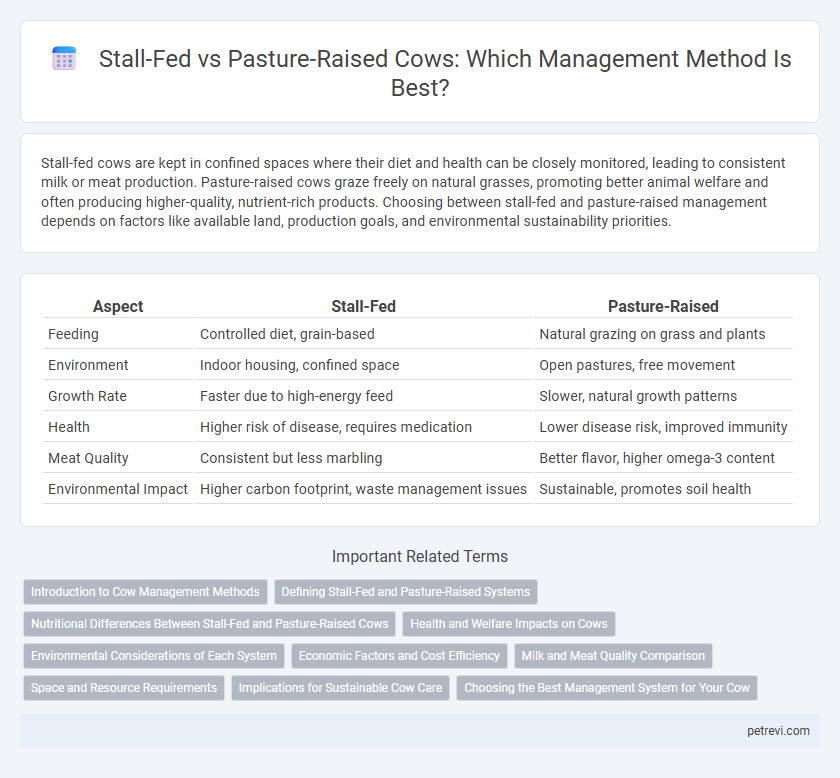Stall-fed cows are kept in confined spaces where their diet and health can be closely monitored, leading to consistent milk or meat production. Pasture-raised cows graze freely on natural grasses, promoting better animal welfare and often producing higher-quality, nutrient-rich products. Choosing between stall-fed and pasture-raised management depends on factors like available land, production goals, and environmental sustainability priorities.
Table of Comparison
| Aspect | Stall-Fed | Pasture-Raised |
|---|---|---|
| Feeding | Controlled diet, grain-based | Natural grazing on grass and plants |
| Environment | Indoor housing, confined space | Open pastures, free movement |
| Growth Rate | Faster due to high-energy feed | Slower, natural growth patterns |
| Health | Higher risk of disease, requires medication | Lower disease risk, improved immunity |
| Meat Quality | Consistent but less marbling | Better flavor, higher omega-3 content |
| Environmental Impact | Higher carbon footprint, waste management issues | Sustainable, promotes soil health |
Introduction to Cow Management Methods
Stall-fed and pasture-raised are two primary cow management methods that influence animal welfare, growth rates, and milk production. Stall-fed cows are housed indoors, receiving controlled feed and protection from environmental elements, which can enhance feed efficiency and reduce disease exposure. Pasture-raised cows graze freely on natural forage, promoting natural behaviors and potentially improving meat and milk quality through diverse diets rich in nutrients.
Defining Stall-Fed and Pasture-Raised Systems
Stall-fed systems confine cows to indoor environments where they are provided with controlled feed such as silage, grains, and hay, ensuring consistent nutrition and minimizing environmental exposure. Pasture-raised cows graze freely on open fields, benefiting from natural forage which supports animal welfare and biodiversity while often leading to variations in diet quality. Each management style impacts cattle growth rates, health outcomes, and environmental sustainability differently, influencing farm operational practices and product characteristics.
Nutritional Differences Between Stall-Fed and Pasture-Raised Cows
Stall-fed cows generally consume a controlled diet rich in grains, silage, and supplements, resulting in higher energy intake and consistent protein levels that promote faster weight gain and milk production. Pasture-raised cows graze on diverse grasses and legumes, providing higher levels of omega-3 fatty acids, antioxidants such as vitamin E, and conjugated linoleic acid (CLA), which enhance meat and milk quality. Nutritional differences directly influence the fatty acid profile, micronutrient content, and overall health benefits of cow-derived products, making pasture-raised beef and dairy often preferred for their superior nutritional profiles.
Health and Welfare Impacts on Cows
Stall-fed cows tend to experience limited mobility, leading to increased risks of lameness, respiratory issues, and stress-related behaviors, which can negatively impact overall health and welfare. Pasture-raised cows benefit from natural grazing, increased exercise, and social interaction, promoting better physical condition, stronger immune systems, and reduced stress levels. Studies show that pasture management reduces incidence of metabolic disorders and improves longevity compared to confined feeding systems.
Environmental Considerations of Each System
Stall-fed cows concentrate waste in confined areas, increasing risks of soil and water contamination if manure is not managed properly, but allow for controlled nutrient recycling and reduced land degradation. Pasture-raised cows promote natural grazing behavior and improve soil health through nutrient deposition and vegetation cycling, yet large grazing areas may contribute to habitat disruption and methane emissions from enteric fermentation. Balancing feed efficiency, land use, and greenhouse gas emissions is critical to minimizing the environmental footprint in both stall-fed and pasture-raised cow systems.
Economic Factors and Cost Efficiency
Stall-fed cattle usually require higher upfront costs due to feed purchase and housing infrastructure but offer better control over diet and growth rates, potentially leading to faster market readiness. Pasture-raised cows benefit from lower feed expenses as they graze on natural forage, reducing daily operational costs and enhancing sustainability, yet may face slower weight gain and variable market prices. Economic efficiency depends on factors like local feed prices, land availability, and market demand for grass-fed versus grain-fed beef.
Milk and Meat Quality Comparison
Stall-fed cows often produce milk with higher fat content due to controlled diets rich in grains, while pasture-raised cows yield milk with greater omega-3 fatty acids and antioxidants, enhancing nutritional quality. Meat from pasture-raised cattle typically has lower saturated fat and higher levels of conjugated linoleic acid (CLA), contributing to better cardiovascular health benefits compared to stall-fed counterparts. Consumers seeking organic and natural milk and meat products tend to prefer pasture-raised options for their superior flavor profile and improved animal welfare standards.
Space and Resource Requirements
Stall-fed cows require confined space with controlled feeding systems, often demanding higher inputs of concentrated feed and water to maintain health and productivity. Pasture-raised cows utilize open grazing areas, needing larger land areas but benefiting from natural forage, which can reduce feed costs and promote animal welfare. Efficient resource management in pasture systems depends on pasture quality and rotational grazing practices to sustain soil health and provide adequate nutrition.
Implications for Sustainable Cow Care
Stall-fed cows offer controlled nutrition and reduced land use, but require careful waste management to prevent environmental degradation. Pasture-raised cows promote natural grazing behaviors and enhance soil health through nutrient cycling, contributing to biodiversity and carbon sequestration. Sustainable cow care balances these methods by integrating rotational grazing and efficient feed strategies to optimize animal welfare and ecological impact.
Choosing the Best Management System for Your Cow
Stall-fed cows benefit from controlled diets that optimize nutrient intake and prevent overgrazing, leading to consistent milk and meat production. Pasture-raised cows experience natural growth environments that enhance animal welfare and improve the nutritional profile of dairy and beef products. Selecting the best management system involves evaluating factors like farm size, climate, labor availability, and the specific production goals to ensure optimal health and productivity for the herd.
Stall-Fed vs Pasture-Raised for Cow Management Infographic

 petrevi.com
petrevi.com